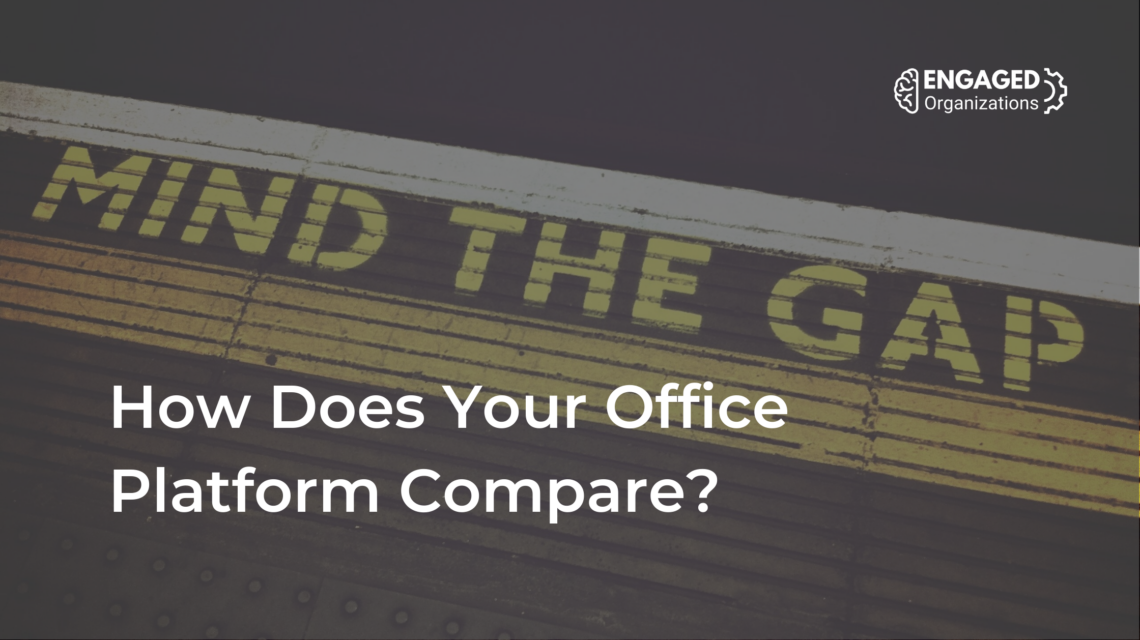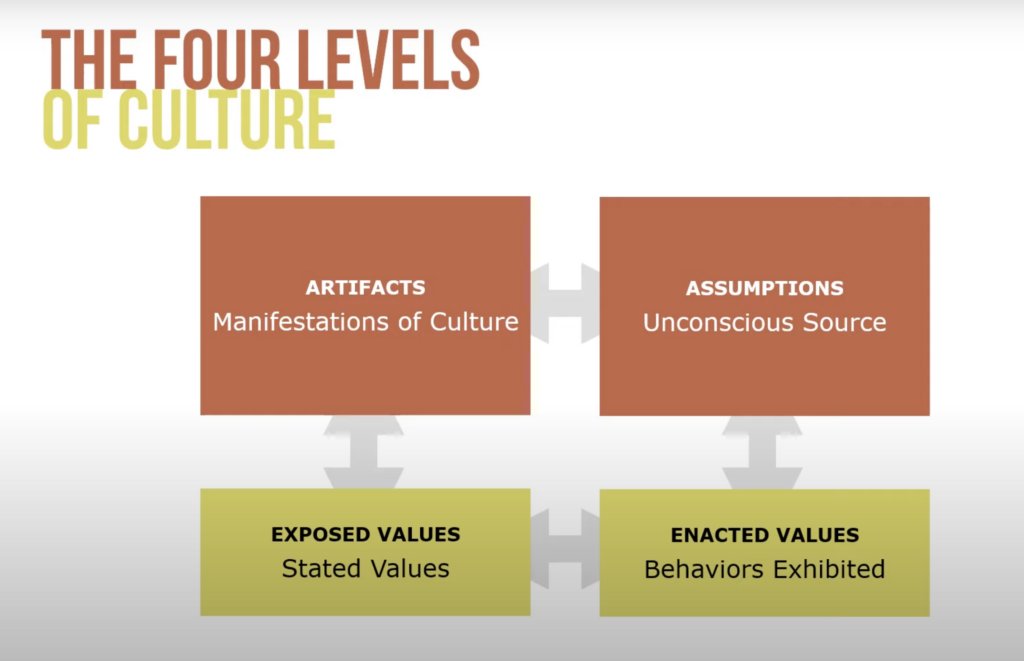The hybrid workplace is challenging many organizations but most are not thinking about their office space as a competing channel to email, enterprise social networks, and intranets. More than that, they are not thinking holistically about the employees experience with each channel and platform. What is it that makes the office a better, more alluring alternative to working remotely? Why do employees give up to be there and what do they get?
Owl Labs research reports that employees spend $51 per day to be in the office. That does not include the time spent commuting, which is just shy of 30 minutes each direction in the United States, based on census data. A general hourly wage for someone making $100,000 in annual salary is also about $50 / hr, which could be considered opportunity cost. Assuming there are 260 work days in a year, that represents $26,000. What about the office is SO good that someone would invest $26,000 of their salary to be there every day?
Design Rewards Behaviors by Centering on the Employee Experience
The challenge for organizations: designing an office ‘channel’ that is worth $100 / day to the employee.
Long before COVID hit, I worked remotely and did long for the adult comradely of the office. I had also started thinking about what I had learned about design in online communities and had the opportunity to visit to the community center at Mount Holyoke College (see picture). I dreamed of building local, in-person community centers that would relieve the stress of employees while also giving them opportunities to connect, socialize, and build relationships. I thought of these community centers as a cross between co-working, high-end cafeteria, and event spaces.
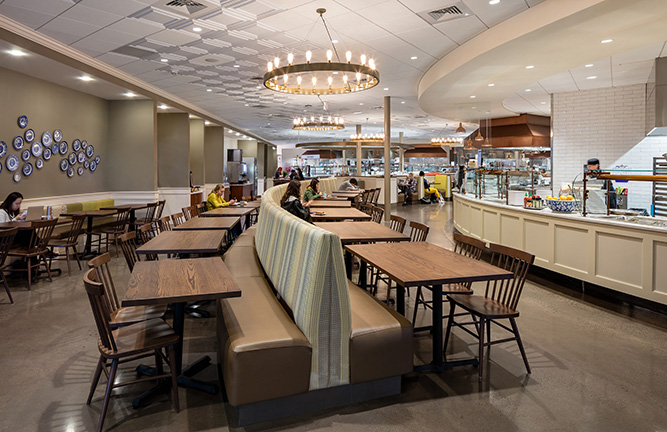
My vision of the space went one step further. I wanted these centers to be a platform that would strengthen the community by making relationships across multiple groups easy. What I imagined was a space that included:
- Multiple rooms, food stations, cafe spaces, and seating configurations for different size groups.
- Easy reconfiguration for working, eating, meeting, workshops, and small events.
- Mini retail ‘shops’ for local bookstores, libraries, bakeries, clothing stores, and more.
- A pick-up and drop-off location for dry cleaning, farm shares, or other services.
- Displayed art from local galleries and schools.
- A small grocery stall for in-demand things like milk, eggs, bread, etc.
- Display and advertising for schools, government, and community groups.
- Areas for local businesses to do demos, Q&A sessions, or to make themselves available for conversations.
The design would focus on enhancing the life of an employee rather than adding additional costs to bear.
Fast forward a few years and the pandemic abruptly eliminated commutes. Not commuting gave people hours back every day to make/pick up dinner, connect with their families, and do errands – all the things that keep them sane even if they also missed some of the benefits of being in the office. However after experiencing the feeling of sanity, is it any surprise they are not interested in returning to the office?
Now it is organizations that need to rethink how their offices can become compelling platforms that make work so easy, meaningful, and delightful that employs are compelled to visit the office on a regular basis and have the time, opportunity, and spaces to connect, build relationships, and develop a sense of community.
Why Would Employees Come Back to the Office?
Executives would like things to go back to ‘normal’ but the mirage is broken; employees know they can be productive while working remotely. Executives, however, realized that away from the office, employees are less connected and engaged in the wider organizational culture, which has a whole range of implicit benefits that were previously taken for granted. The office is now competing with wherever employees would rather be, whether that is at home or in Hawaii and costing employees in both time and money. That’s pretty tough competition especially if you factor in the cost for individuals of a work wardrobe, the cost and time spent commuting, the opportunity cost of not exercising, and the time to see children off to school and for dinner every day. The office has no competitive advantage, as they say in marketing. The office experience needs a reboot if it is going to entice people to return.
Some CEOs, like Goldman Sachs’ David Solomon, are so adamant about the value of the office that he is mandating that employees return. I suspect Goldman Sachs can do this because a large percentage of its employees are young and its jobs are highly prized. I would argue that in their case, where they need a high velocity of learning, it might be more effective to have a day at the office for intense learning followed by a day of remote work to reflect and apply new approaches. Companies without the draw of Goldman Sachs will have to be more creative given unemployment is at a 50-year low.
A View from the Office
I had the opportunity to discuss how organizations are transitioning to hybrid work with Ted Hopton, a Technology Experience Strategist at Motorola Solutions, and John Day, Director of Member Products and Programs at IEEE. They both have years of experience working with employees and organizations to make them more transparent and collaborative. Neither was particularly bullish on the future of the office as it stands today.
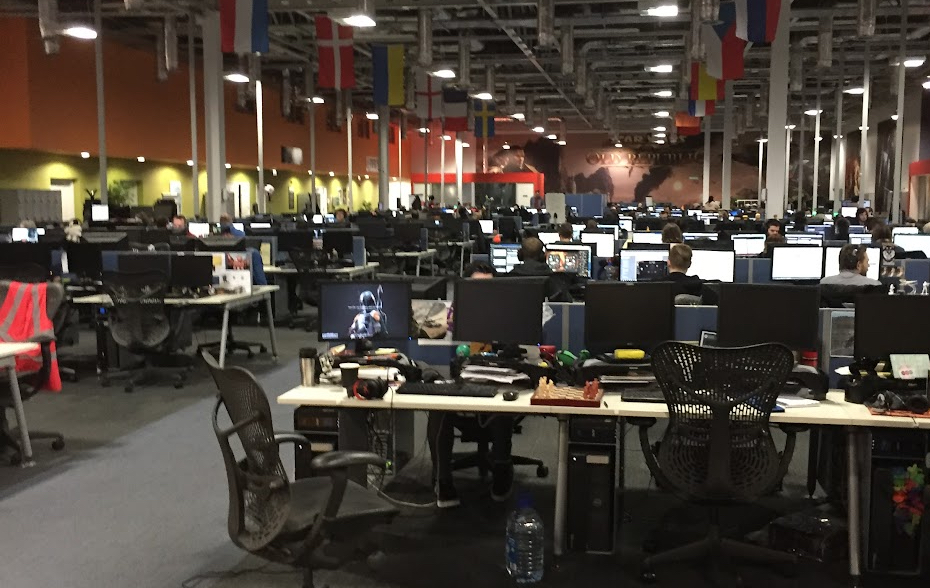
Ted suggested the transition to a hybrid workplace model should take lessons from how some schools have shifted to a ‘Flipped Classroom’ model, such that time spent in the office would be focused on whatever can be best accomplished face-to-face, while independent work would be done remotely. Those of you reading this likely sat in a row of desks throughout your academic career. My daughter, until the social distancing required for COVID, had never sat at a desk all day. Instead, she has always moved about classrooms transitioning in and out of collaborative work. The teachers support the students by facilitating, not lecturing. Independent work is mostly reserved for homework when they are physically alone. That is a ‘flipped’ model with the children rather than the teacher at the center.
John Day reflected that today offices are designed for independent work – with lots of desks, fluorescent lights, and cubes. These spaces are not exactly conducive to connection, trust-building, and collaboration – especially if employees are not taking opportunities to connect when they are there. John notes,
“When employees pass each other in the hallway without greeting each other, what value-add is an office delivering? Employees in the office seated 15 feet apart IM’ing – what organizational culture is that advancing?”
Hybrid work, especially when it is ad hoc, results in different people and groups in the office on different days. They face a sea of empty desks. The result is a feeling of emptiness and loss – not exactly the energizing or inspiring feeling that is going to draw people back. The space is not designed for the way we are now working. Like schools and libraries, offices need to evolve to offer opportunities that cannot be delivered digitally.
The hybrid working environment will likely drive more mindful decision-making around communications respective to office vs. remote working. To the extent positive organizational culture rests upon in-person interaction and spontaneous chats, the onus is on the organization to reflect on how these encounters are practiced and, perhaps now, consider more deliberate planning to catalyze the desired engagements. As long as communication and work practices are the same in-office as when employees are remote, the perception of the office’s value-add will be perennially scrutinized.
What is the ROI of Your Office?
There is value in being together in person; the energy of connecting and the volume of information exchanged simply cannot be replicated through digital channels. Physical interactions and spending time together accelerates rapport and trust, which is critical for operational efficiency. Without trust, everything takes longer and requires more processes and verification.
Some of the use cases enhanced by being together are:
- Onboarding new employees and offering them opportunities to build relationships with teammates.
- Mentoring and developing people early in their career and giving them access to mentors and each other.
- Having hard conversations – whether that is about business strategy, organizational changes, work progress, or professional development.
- Creating a shared understanding and team culture at the start of a project.
- Building cross-functional relationships.
- Evaluating progress, identifying gaps, and addressing opportunities.
- Creating a shared understanding of a complex problem.
- Brainstorming and designing new solutions and approaches.
Thinking about these use cases, what locations and environments would be most conducive to success? What services could be aggregated within the office platform to make these use cases easier and more rewarding?

It is probably not a sea of individual desks, each with a desktop computer and a phone on it. How can we design offices that give employees an ROI for coming into the office?
I use B.J. Fogg’s Behavior Model to frame my thinking about designing environments for specific behaviors. Motivation, triggers, and ease are the conditions required for people to behave in certain ways. I add an additional line for value because there is a trade-off between investment in the environment and the value generated by behaviors. Together it creates the business model for any environment, communication platform, or physical space.
How do we design offices for behaviors that are most accelerated by being together?
Designing the Office as a Platform
When I think of the office of the future, I think about my vision of a community center that mashes up space with services and makes a variety of collaborative behaviors easy in ways that make employees’ lives better rather than more complicated. Do that and employees will return again and again because it gives them more than it costs.
Some spaces I have visited had elements of what a future office might look including:
- An organizational conference/event center that provides catering, AV support, and a mix of rooms.
- A comfortable, quiet, and inviting space that has a wide variety of small group settings to support a variety of activities; individual pods, small cafe tables in enclosed spaces for one-on-one conversations, lounge areas for unstructured group conversations, areas with whiteboards and high-top tables for workshops, lounge areas with screens, and large stadium seating areas.
- A unique location that takes people out of the office context and gives them unexpected experiences and prompts an array of interactions.
- Offices with large lounge and cafe areas, which encourage ‘collisions’ between employees in different roles, groups, and teams.
- Campuses that consolidate an array of services like a daycare, pharmacy, urgent care, dry cleaning, hair salon, restaurants, etc which save people time.
Most of the offices are less inspired and inspiring. They have long, dark hallways and are filled with furniture from the local office supply store. All grey. These spaces are neither optimized for individual work nor collaborative work. They are the worst of both worlds. As John puts it, “When an employee expends $10 on gas and 60 minutes commuting daily, an IM from their manager seated 15 feet away hardly reinforces the value-add of an office.”
One of the early insights from WeWork was that they could differentiate their co-working spaces by hiring community managers to help connect clients and ensure people had the services they needed to focus on work. If we want our offices to help increase connections, relationships, and a sense of belonging, hiring community management and meeting facilitation staff will help optimize time spent in the office.
Walking the Walk: Modeling Connection
We have adjusted to remote and now hybrid work, so your organization is likely getting along OK but chances are you have not yet seen significant changes to physical infrastructure. Part of the challenge is that designing offices for hybrid work requires reflection and planning about how work practices will change. What percentage of collaborative work is best done by brainstorming vs. presentations vs. discussions? Those different behaviors are optimized in different spaces.
Doing a culture and work pattern audit is a good way to understand how the organization works today and where there are opportunities to improve it. One framework to help understand your current culture, its strengths, and opportunities in this simple framework from GreggU’s video, Four Levels of Organizational Culture, which asked the following questions:
- What artifacts can you point to that demonstrate your culture?
- What assumptions do people make and how do they influence behavior?
- What values does the organization expose?
- What values are exhibited through behaviors?
This audit will help identify and prioritize what kind of space and environments will offer the biggest opportunities to enhance your organization’s culture.
After auditing your organization’s cultural strengths and opportunities, it is useful to get specific about the platforms used in your organization and how they are used. For example:
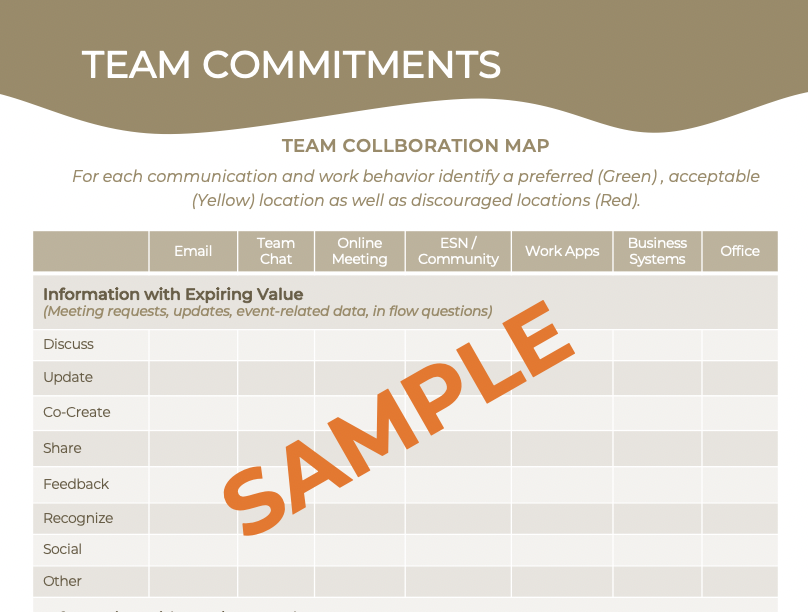
- Where do employees go to ask questions? Is that the best place for them to do so? If not, why not?
- What factors determine what platform is the best channel for asking a question? What types of questions are best aligned with different platforms?
- Where should questions not be asked (like deep in a business application where they are not likely to be seen or found by others)?
The Engaged Organization’s Becoming Hybrid: A Team Collaboration Handbook offers some exercises to prompt articulation of how work happens and how to coordinate work across platforms in order to reduce competition and take advantage of network effects.
Depending on your organization and how consistent the work is across teams, functional groups, business units, and geographies it may be effective to standardize the use of some platforms across the organization while leaving the use of other channels up to teams or individuals. Including the office as one of many platforms and channels can help pinpoint where it is uniquely suited to support behavior and for which behaviors there are many equally effective platforms.
By completing this analysis you will likely start to see which behaviors and workflows are best accelerated by being together. That will help prioritize how the office needs to be reconfigured.
Final Thoughts
Design has a profound impact on how people feel, how easy it is to behave in certain ways, and how conducive a platform is to its purpose – this is the same for physical spaces as it is for digital spaces. Understanding, articulating, designing for, and rationalizing behaviors across platforms increases the growth of those behaviors.
Understanding your organization’s operational strategy, whether explicit or not, will also inform decisions. Does your organization invest in customer and employee experience or does it spend only what it considers absolutely necessary or somewhere in the middle? Does your organization reward leaders for catalyzing interactions and collaboration?
Thinking about the office as a platform – part of the portfolio of infrastructure that your organization invests in and maintains to support its work – will help understand its most effective use. It is both one of the most expensive infrastructures your organization invests in and the infrastructure with the most potential to help connect and engage employees.


